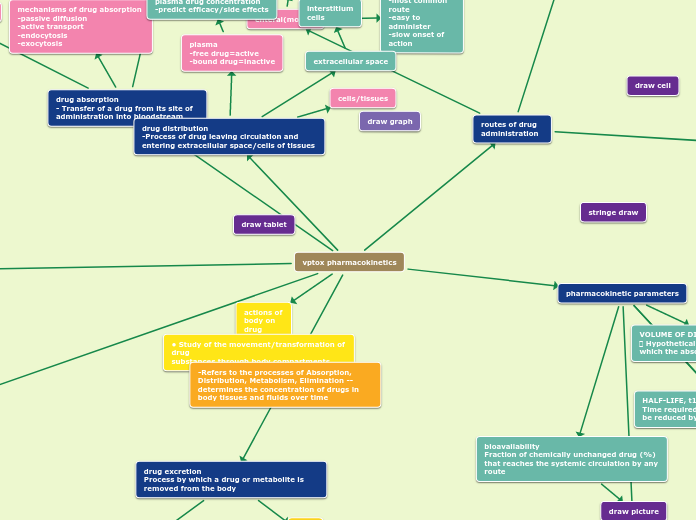draw cell
draw tablet
stringe draw
draw graph
vptox pharmacokinetics
pharmacokinetic parameters
steady state plasma conc
Repeated dosing of a drug at regular intervals,
HALF-LIFE, t1/2
Time required for concentration of drug to be reduced by half.
draw pic
CLEARANCE, Cl
A measure of the capacity of the body to
remove a drug.
VOLUME OF DISTRIBUTION, Vd
Hypothetical volume of body fluid into which the absorbed drug is disseminated
bioavailability
Fraction of chemically unchanged drug (%) that reaches the systemic circulation by any route
draw picture
drug excretion
Process by which a drug or metabolite is removed from the body
fecal
lung
milk
renal
most common
3 processes
filtration
secretion
reabsoption
filtration - glomerular filtration rate
secretion - takes place in proximal convoluted tube
reabsorption - takes place in distal convoluted tube
Urine pH
• Urine flow rate
• Plasma protein binding
• Competition for active tubular secretion • State of renal function
drug biotransformation(metabolism)
-Chemical modification of compound by an organism
enterohepatic cycling
-drug excreted through bile
-reabsorbed in small intestine
-recycled to liver through hepatic portal vein
first pass effect
-have to pass through liver before reaching circulation
factors affecting
genetic diseases
liver diseases
phase 1
phase 2
Endogenous substrates
Animo acid
Glucuronic acid
Sulfuric acid
Acetic acid
Drugs NOT eliminated in phase I undergo phase II
make drugs water-soluble for
elimination through kidneys.
Cytochrome P-450 being the major enzymes
chemical reactions
-oxidation
-reduction - hydrolysis
Convert parent drug to a more polar metabolite by introducing/unmasking polar functional group
purposes
• Inactivate drug
• Converting to water-soluble form for elimination by the kidneys
drug distribution
-Process of drug leaving circulation and entering extracellular space/cells of tissues
cells/tissues
extracellular space
interstitium
cells
movement depends on
-drug properties
-blood flow
-capillary permeability
plasma
-free drug=active
-bound drug=inactive
plasma drug concentration
-predict efficacy/side effects
factors affecting plasma drug conc
-dosage form
-drug-drug interaction
drug absorption
- Transfer of a drug from its site of administration into bloodstream
mechanisms of drug absorption
-passive diffusion
-active transport
-endocytosis
-exocytosis
factors affecting absorption
disease status of patients
-GI disease
-cardiac disease=less blood flow=less absorption
drug-drug interaction
-can increase or inhibit absorption
dosage forms
-affect dissolution therefore absorption
surface area for absorption
-bigger surface area=greater absorption
blood flow to site
-more blood flow = greater absorption
drug properties
-size
-hydrophilicity
-hydrophobicity
routes of administration
-iv -im -oral
oral route absorption
-stomach
-small intestine
drug dosage forms
-physical form of drug intended for administration via various routes.
rectal
-enemas
-enemas
transdermal
-patches
-plasters
topical
-cream
-gel
intranasal
-spray
inhalation
-aerosol
injectables
solution
oil
(by IV or direct injection)
sublingual
tablets
chewing gums
oral
liquid
-emulsions
-solutions
solid
-capsules
-powders
routes of drug administration
others
transdermal
-drug absorbed into skin
rectal
-administered through the rectum
topical
-directly into affected areas
intranasal
-directly into nose
inhalational
-deep breathing of drug into respiratory tract
parental (injection)
-avoids first pass effect in liver
-contamination
IV
-inject directly into vein
IM
-injected into muslce
ID
-injected into skin
SC
-injected into fatty layer of tissue below skin
IP
-injectected into intraperitoneal cavity
EPIDURAL
-injected into space outside
dura matter
intrathecal and intracerebroventricular
-injected into csf cerebrospinal fluid
enteral(mouth)
sublingual
-drug absorbed by normal mucosa
-avoid first pass effect of liver
-can only administer small quantity of drug
oral
-most common route
-easy to administer
-slow onset of action
actions of body on drug
• Study of the movement/transformation of drug
substances through body compartments
-Refers to the processes of Absorption, Distribution, Metabolism, Elimination --determines the concentration of drugs in body tissues and fluids over time

